The Grand Canyon 2002 Seminar
- More Data on Genesis
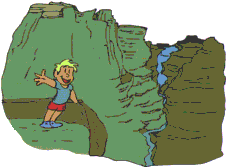 On February 8, 2002, we awoke to a beautiful cold Arizona winter day.
After many months of planning and arranging, 32 people from all over the
United States were to walk together to the very bottom of the Grand Canyon,
spend the night, and then walk out the following day. This is no small fete,
because the Canyon is very close to a mile vertically in depth. Going down
is always the worst part. Human knees are not made for lowering the weight
of one's body (plus all that is in his/her pack) 5,200 feet. By the time
I got to the bottom, my knees felt as if they were made out of Jell-O. After
a night of rest in a dorm shared with nine other people, you get to lift
all of that, including your trash, straight up another 5,200 feet. Your
muscles for the next day or so cause you to move with what is known as the
Phantom Creep (named after Phantom Ranch, the place you stay at the bottom
of the Canyon). Phantom Ranch serves great meals made from food hauled down
by mules, and the beds are comfortable. Our 32 folks did extremely well
with all of this, and great friendships and associations developed as we
supported and encouraged one another through freezing temperatures, icy trails,
and heavy winds. Fortunately we did not have to deal with rain or snow,
but we were glad we all had crampons for the ice on the trail during the
last mile and a half coming out.
On February 8, 2002, we awoke to a beautiful cold Arizona winter day.
After many months of planning and arranging, 32 people from all over the
United States were to walk together to the very bottom of the Grand Canyon,
spend the night, and then walk out the following day. This is no small fete,
because the Canyon is very close to a mile vertically in depth. Going down
is always the worst part. Human knees are not made for lowering the weight
of one's body (plus all that is in his/her pack) 5,200 feet. By the time
I got to the bottom, my knees felt as if they were made out of Jell-O. After
a night of rest in a dorm shared with nine other people, you get to lift
all of that, including your trash, straight up another 5,200 feet. Your
muscles for the next day or so cause you to move with what is known as the
Phantom Creep (named after Phantom Ranch, the place you stay at the bottom
of the Canyon). Phantom Ranch serves great meals made from food hauled down
by mules, and the beds are comfortable. Our 32 folks did extremely well
with all of this, and great friendships and associations developed as we
supported and encouraged one another through freezing temperatures, icy trails,
and heavy winds. Fortunately we did not have to deal with rain or snow,
but we were glad we all had crampons for the ice on the trail during the
last mile and a half coming out.
The purpose the Does God Exist?
program has in arranging trips like this is primarily educational in nature.
There is a huge amount of misleading, incomplete, and inaccurate information
circulated about the Grand Canyon, both by denominational creationists and
biblical skeptics. There is no better way to dispel all of this bad information
than to allow people to see for themselves what the evidence is and understand
why the claims about the Canyon that are incorrect are wrong from the evidence--not
just because of someone's opinion.
As we gathered together at the Kaibab trailhead on that Friday morning,
we discussed the options as to how the Canyon was produced. There are two
basic issues involved in the production of the Canyon. The first is the question
of how the rocks were produced, and the second is how the Canyon was actually
carved and why it looks like it does. Connected to both of these questions
is the issue of time. How long did it take for all of this to happen? It
is the purpose of this article to not only tell our regular readers about
the trip, but also to answer these questions.
How Were The Rock Produced?
There are three basic kinds of rocks found on planet Earth. The first
is volcanic rocks. These are rocks which were melted earth materials that
cooled and became rocks. The second is sedimentary rocks which are materials
produced by running water or wind and cemented together to make rock. The
third type of rock is metamorphic rock, which is a sedimentary or volcanic
rock which has been changed by being heated and/or squeezed by high pressure.
All three kinds of rock are found in the Grand Canyon and all tell us about
how the material that makes up the Canyon was produced. The fact that all
three types of rock are present means that there was no one cause to
the Canyon. It is not possible for the flood of Noah to have laid down the
Canyon rocks because most of the rocks are not rocks that a flood would produce.
As we started walking down the Kaibab Trail, we immediately saw that the
top layer of the Canyon was a limestone named the Kaibab limestone. Limestone
is a chemically precipitated rock produced only in quiet ocean water over
long periods of time. Hundreds of fossils of ocean creatures can be seen
in the limestone with no fossils of land animals of any kind. In the Kaibab
limestone, we saw large chert inclusions and quartz geodes--crystals of glass
growing in the calcium carbonate limestone--another process that requires
a quiet ocean environment and long periods of time. You can see rock like
this being produced in the Caribbean and other oceans today--very slowly
and in flat layers--a major clue as to what produced the Canyon itself.
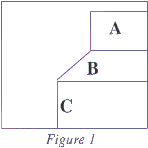 Shortly after leaving the very hard and tough Kaibab limestone, there was
an obvious change in the appearance of the layers. We saw a shale layer that
was much less steep than the limestone layer and much softer. The rocks were
coming off in thin layers and sliding down an incline. Shale is mud which
has been turned into rock. The stair step appearance of the Grand Canyon
is due to the difference in the rocks. Hard rocks like the Kaibab limestone
do not crumble easily, being harder than concrete. They collapse when undercut
leaving huge massive bluffs like A and C in Figure 1. Shale crumbles and
slides easily, making areas like B. The basic appearance of the Canyon is
due to alternating layers of materials of differing hardness
Shortly after leaving the very hard and tough Kaibab limestone, there was
an obvious change in the appearance of the layers. We saw a shale layer that
was much less steep than the limestone layer and much softer. The rocks were
coming off in thin layers and sliding down an incline. Shale is mud which
has been turned into rock. The stair step appearance of the Grand Canyon
is due to the difference in the rocks. Hard rocks like the Kaibab limestone
do not crumble easily, being harder than concrete. They collapse when undercut
leaving huge massive bluffs like A and C in Figure 1. Shale crumbles and
slides easily, making areas like B. The basic appearance of the Canyon is
due to alternating layers of materials of differing hardness
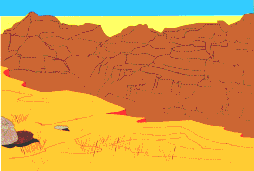 Not very far down the walk, we came to a formation called the Coconino sandstone.
This is sand turned into rock. There are two ways that sand can do this--to
be produced by wind or by running water. If the sand grains are carried
by wind, they get scratched by banging into each other. If they are carried
by running water, they do not go fast enough to scratch. We had a hand lens
available for our group to look at these sand grains, and there was no question
that they are heavily scratched and frosted by banging into each other.
The angle of deposit and footprints also testify to the fact that this is
a sand dune, not a marine environment like the rocks above it.
Not very far down the walk, we came to a formation called the Coconino sandstone.
This is sand turned into rock. There are two ways that sand can do this--to
be produced by wind or by running water. If the sand grains are carried
by wind, they get scratched by banging into each other. If they are carried
by running water, they do not go fast enough to scratch. We had a hand lens
available for our group to look at these sand grains, and there was no question
that they are heavily scratched and frosted by banging into each other.
The angle of deposit and footprints also testify to the fact that this is
a sand dune, not a marine environment like the rocks above it.
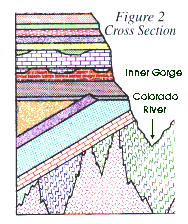 As we neared the bottom of the Canyon, we began to see obvious changes in
the rocks. One new layer was a quartzite--a metamorphic rock produced by
putting pressure and heat on a sandstone. We also saw a schist--another metamorphic
rock, and finally the Zororaster granite, a volcanic rock with huge crystals
produced in a molten mass and allowed to cool very, very slowly. At the
top of all of this changed and volcanic rock were short highly-tilted sedimentary
beds (see Figure 2) which Alan Doty, our team geologist and expert on the
Canyon informed us have now been calculated from exposures elsewhere in the
Canyon to be 12,000 feet thick. What that means is that in the history of
the Grand Canyon's deposition, there have been some 20,000 feet of rock laid
down.
As we neared the bottom of the Canyon, we began to see obvious changes in
the rocks. One new layer was a quartzite--a metamorphic rock produced by
putting pressure and heat on a sandstone. We also saw a schist--another metamorphic
rock, and finally the Zororaster granite, a volcanic rock with huge crystals
produced in a molten mass and allowed to cool very, very slowly. At the
top of all of this changed and volcanic rock were short highly-tilted sedimentary
beds (see Figure 2) which Alan Doty, our team geologist and expert on the
Canyon informed us have now been calculated from exposures elsewhere in the
Canyon to be 12,000 feet thick. What that means is that in the history of
the Grand Canyon's deposition, there have been some 20,000 feet of rock laid
down.
How long does it take to deposit 20,000 feet of limestone, shale, sandstone,
and a handful of more exotic sedimentary rocks? A volcanic lava flow can
produce layers of rock in small amounts of time, but producing sedimentary
rocks like limestone is a much slower process requiring thousands of years
just to make a foot of rock. It is also interesting to see the gorgeous colors
that the layers have. In many cases, like the redwall limestone, the beautiful
red limestone is not red at all, but has been stained by iron oxides leached
out of the rocks above it. When the redwall limestone breaks, it is a rather
ordinary cement-looking rock.
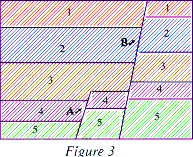 As we walked in this majestic place, we could see evidence of other factors
that have made the Canyon as it is. Faults (or cracks) in the rocks tell
us that pressure has worked on these rocks in many ways. Some faults like
Fault A in Figure 3, must have happened before layers 1, 2, or 3 were deposited.
Other faults like Fault B in Figure 3 must have happened after all five rock
layers were laid down because all five layers have been broken. This is
history we are seeing--not a singular event. To tell children that a flood
or some other event like it laid down the Canyon rocks is horribly destructive
because junior high students can see and do see that there is a history to
read in the Canyon rocks and with just a little study we can all learn to
read it.
As we walked in this majestic place, we could see evidence of other factors
that have made the Canyon as it is. Faults (or cracks) in the rocks tell
us that pressure has worked on these rocks in many ways. Some faults like
Fault A in Figure 3, must have happened before layers 1, 2, or 3 were deposited.
Other faults like Fault B in Figure 3 must have happened after all five rock
layers were laid down because all five layers have been broken. This is
history we are seeing--not a singular event. To tell children that a flood
or some other event like it laid down the Canyon rocks is horribly destructive
because junior high students can see and do see that there is a history to
read in the Canyon rocks and with just a little study we can all learn to
read it.
Just as no single event laid down the rocks of the Grand Canyon, so too
no single event produced the carving of the Canyon. The north rim of the
Canyon is higher than the south rim because the whole area has been bowed
into what is called a monocline (see Figure 4). Such flexing weakens rock
just as bending a stick will weaken it at the point of maximum bending. In
addition to bending and cracks which weaken sections of rock, there is water
in the area running toward the sea. The Colorado River flows in a path that
wanders and winds through the area scouring its bed as it goes. Streams
flowing into the Colorado flow along the faults through weakened rock materials
carving deeper and deeper. All of these things seem to be contributors to
the production of the Canyon. Another obvious contributor is time. How
must time does it take just to carve the Canyon?
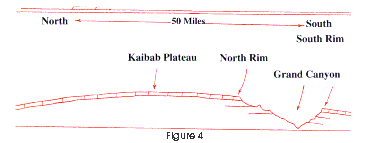
Some science books will point out that the Colorado River is currently
eroding 1/2 foot of rock from the Canyon every 1,000 years. They then suggest
that if you take the 5,000 feet of vertical rock missing from the Canyon and
divide it by .5 feet, it would take 10,000 of the 1,000-year-periods or 10,000,000
years to carve the Canyon. What is wrong with this assertion? Well, first
of all the River is in granite now, which had a different hardness than the
sedimentary rocks above it. More important is the assumption that the volume
of water in the Canyon has been constant. While at Phantom Ranch, we looked
at huge boulders carried miles down the river channel from outcrops upstream.
In the past, glaciers melted, producing massive volumes of water in the
Canyon. Today with Lake Powell controlling the flow (except in a simulation
of Spring floods), no such volume takes place. This is a very obvious case
of bad science.

Another example of bad science comes from creationists who go to places
like Mt. St. Helens in the state of Washington and show huge canyons produced
in the flanks of the mountain since 1980 when the volcano blew, producing
massive amounts of ash, scoria, pumice, and other extruded volcanic
rocks. These rocks are very light weight, easy to erode, and highly porous.
To make comparisons between the Grand Canyon and Mt. St. Helens is like comparing
butter with steel. (For more on this, see "A Visit to Mt. St. Helens," Does
God Exist?, March/April 2001, page 16.)
So how long did it take to produce the Canyon? No one can answer that
question--just as no one can tell you the date of Genesis 1:1. Only
those willing to add to the Word of God will give a date. Many denominational
creationists will do this to defend their man-made creeds and traditions,
but I would suggest that this is a dangerous thing to do. ".If any man shall
add unto these things, God shall add unto him the plagues that are written
in this book. And if any man shall take away from the words of the book of
this prophecy, God shall take away his part out of the book of life, and out
of the holy city, and from the things which are written in this book (Revelation 22:18-19)."
What we see in the Grand Canyon is an incredible testimony to the power,
patience, wisdom, and design of God. In His creation of the earth, God has
produced the elements He knew man would need to survive on the earth, and
He has engineered a planet that processes and redistributes these materials
in such a way that they are always available to man. The Canyon allows us
to see how the insides of this great machine we call Earth works, and what
we need to do to "take care of the Garden, dress it, and keep it." Genesis 1:1 tells
us God created it, not how or when or how it works; but God has given man
a curiosity and an intellect so that we can meet our physical needs. He has
also provided for our spiritual needs.
As a group of us were hiking up out of the Canyon, we stopped at a lookout
to catch our breath and watched the sun start to illuminate the redwall limestone
across the Canyon from where we stood. One of the women standing there with
us said, "And God saw that it was very good." We all responded in unison--"Amen."
And God saw every thing that he had made, and, behold, it was very
good. And the evening and the morning were the sixth day (Genesis 1:31).
--John N. Clayton
Back to Contents Does God Exist?, SepOct02.
 Shortly after leaving the very hard and tough Kaibab limestone, there was
an obvious change in the appearance of the layers. We saw a shale layer that
was much less steep than the limestone layer and much softer. The rocks were
coming off in thin layers and sliding down an incline. Shale is mud which
has been turned into rock. The stair step appearance of the Grand Canyon
is due to the difference in the rocks. Hard rocks like the Kaibab limestone
do not crumble easily, being harder than concrete. They collapse when undercut
leaving huge massive bluffs like A and C in Figure 1. Shale crumbles and
slides easily, making areas like B. The basic appearance of the Canyon is
due to alternating layers of materials of differing hardness
Shortly after leaving the very hard and tough Kaibab limestone, there was
an obvious change in the appearance of the layers. We saw a shale layer that
was much less steep than the limestone layer and much softer. The rocks were
coming off in thin layers and sliding down an incline. Shale is mud which
has been turned into rock. The stair step appearance of the Grand Canyon
is due to the difference in the rocks. Hard rocks like the Kaibab limestone
do not crumble easily, being harder than concrete. They collapse when undercut
leaving huge massive bluffs like A and C in Figure 1. Shale crumbles and
slides easily, making areas like B. The basic appearance of the Canyon is
due to alternating layers of materials of differing hardness On February 8, 2002, we awoke to a beautiful cold Arizona winter day.
After many months of planning and arranging, 32 people from all over the
United States were to walk together to the very bottom of the Grand Canyon,
spend the night, and then walk out the following day. This is no small fete,
because the Canyon is very close to a mile vertically in depth. Going down
is always the worst part. Human knees are not made for lowering the weight
of one's body (plus all that is in his/her pack) 5,200 feet. By the time
I got to the bottom, my knees felt as if they were made out of Jell-O. After
a night of rest in a dorm shared with nine other people, you get to lift
all of that, including your trash, straight up another 5,200 feet. Your
muscles for the next day or so cause you to move with what is known as the
Phantom Creep (named after Phantom Ranch, the place you stay at the bottom
of the Canyon). Phantom Ranch serves great meals made from food hauled down
by mules, and the beds are comfortable. Our 32 folks did extremely well
with all of this, and great friendships and associations developed as we
supported and encouraged one another through freezing temperatures, icy trails,
and heavy winds. Fortunately we did not have to deal with rain or snow,
but we were glad we all had crampons for the ice on the trail during the
last mile and a half coming out.
On February 8, 2002, we awoke to a beautiful cold Arizona winter day.
After many months of planning and arranging, 32 people from all over the
United States were to walk together to the very bottom of the Grand Canyon,
spend the night, and then walk out the following day. This is no small fete,
because the Canyon is very close to a mile vertically in depth. Going down
is always the worst part. Human knees are not made for lowering the weight
of one's body (plus all that is in his/her pack) 5,200 feet. By the time
I got to the bottom, my knees felt as if they were made out of Jell-O. After
a night of rest in a dorm shared with nine other people, you get to lift
all of that, including your trash, straight up another 5,200 feet. Your
muscles for the next day or so cause you to move with what is known as the
Phantom Creep (named after Phantom Ranch, the place you stay at the bottom
of the Canyon). Phantom Ranch serves great meals made from food hauled down
by mules, and the beds are comfortable. Our 32 folks did extremely well
with all of this, and great friendships and associations developed as we
supported and encouraged one another through freezing temperatures, icy trails,
and heavy winds. Fortunately we did not have to deal with rain or snow,
but we were glad we all had crampons for the ice on the trail during the
last mile and a half coming out.
 Not very far down the walk, we came to a formation called the Coconino sandstone.
This is sand turned into rock. There are two ways that sand can do this--to
be produced by wind or by running water. If the sand grains are carried
by wind, they get scratched by banging into each other. If they are carried
by running water, they do not go fast enough to scratch. We had a hand lens
available for our group to look at these sand grains, and there was no question
that they are heavily scratched and frosted by banging into each other.
The angle of deposit and footprints also testify to the fact that this is
a sand dune, not a marine environment like the rocks above it.
Not very far down the walk, we came to a formation called the Coconino sandstone.
This is sand turned into rock. There are two ways that sand can do this--to
be produced by wind or by running water. If the sand grains are carried
by wind, they get scratched by banging into each other. If they are carried
by running water, they do not go fast enough to scratch. We had a hand lens
available for our group to look at these sand grains, and there was no question
that they are heavily scratched and frosted by banging into each other.
The angle of deposit and footprints also testify to the fact that this is
a sand dune, not a marine environment like the rocks above it. As we neared the bottom of the Canyon, we began to see obvious changes in
the rocks. One new layer was a quartzite--a metamorphic rock produced by
putting pressure and heat on a sandstone. We also saw a schist--another metamorphic
rock, and finally the Zororaster granite, a volcanic rock with huge crystals
produced in a molten mass and allowed to cool very, very slowly. At the
top of all of this changed and volcanic rock were short highly-tilted sedimentary
beds (see Figure 2) which Alan Doty, our team geologist and expert on the
Canyon informed us have now been calculated from exposures elsewhere in the
Canyon to be 12,000 feet thick. What that means is that in the history of
the Grand Canyon's deposition, there have been some 20,000 feet of rock laid
down.
As we neared the bottom of the Canyon, we began to see obvious changes in
the rocks. One new layer was a quartzite--a metamorphic rock produced by
putting pressure and heat on a sandstone. We also saw a schist--another metamorphic
rock, and finally the Zororaster granite, a volcanic rock with huge crystals
produced in a molten mass and allowed to cool very, very slowly. At the
top of all of this changed and volcanic rock were short highly-tilted sedimentary
beds (see Figure 2) which Alan Doty, our team geologist and expert on the
Canyon informed us have now been calculated from exposures elsewhere in the
Canyon to be 12,000 feet thick. What that means is that in the history of
the Grand Canyon's deposition, there have been some 20,000 feet of rock laid
down. As we walked in this majestic place, we could see evidence of other factors
that have made the Canyon as it is. Faults (or cracks) in the rocks tell
us that pressure has worked on these rocks in many ways. Some faults like
Fault A in Figure 3, must have happened before layers 1, 2, or 3 were deposited.
Other faults like Fault B in Figure 3 must have happened after all five rock
layers were laid down because all five layers have been broken. This is
history we are seeing--not a singular event. To tell children that a flood
or some other event like it laid down the Canyon rocks is horribly destructive
because junior high students can see and do see that there is a history to
read in the Canyon rocks and with just a little study we can all learn to
read it.
As we walked in this majestic place, we could see evidence of other factors
that have made the Canyon as it is. Faults (or cracks) in the rocks tell
us that pressure has worked on these rocks in many ways. Some faults like
Fault A in Figure 3, must have happened before layers 1, 2, or 3 were deposited.
Other faults like Fault B in Figure 3 must have happened after all five rock
layers were laid down because all five layers have been broken. This is
history we are seeing--not a singular event. To tell children that a flood
or some other event like it laid down the Canyon rocks is horribly destructive
because junior high students can see and do see that there is a history to
read in the Canyon rocks and with just a little study we can all learn to
read it. 
